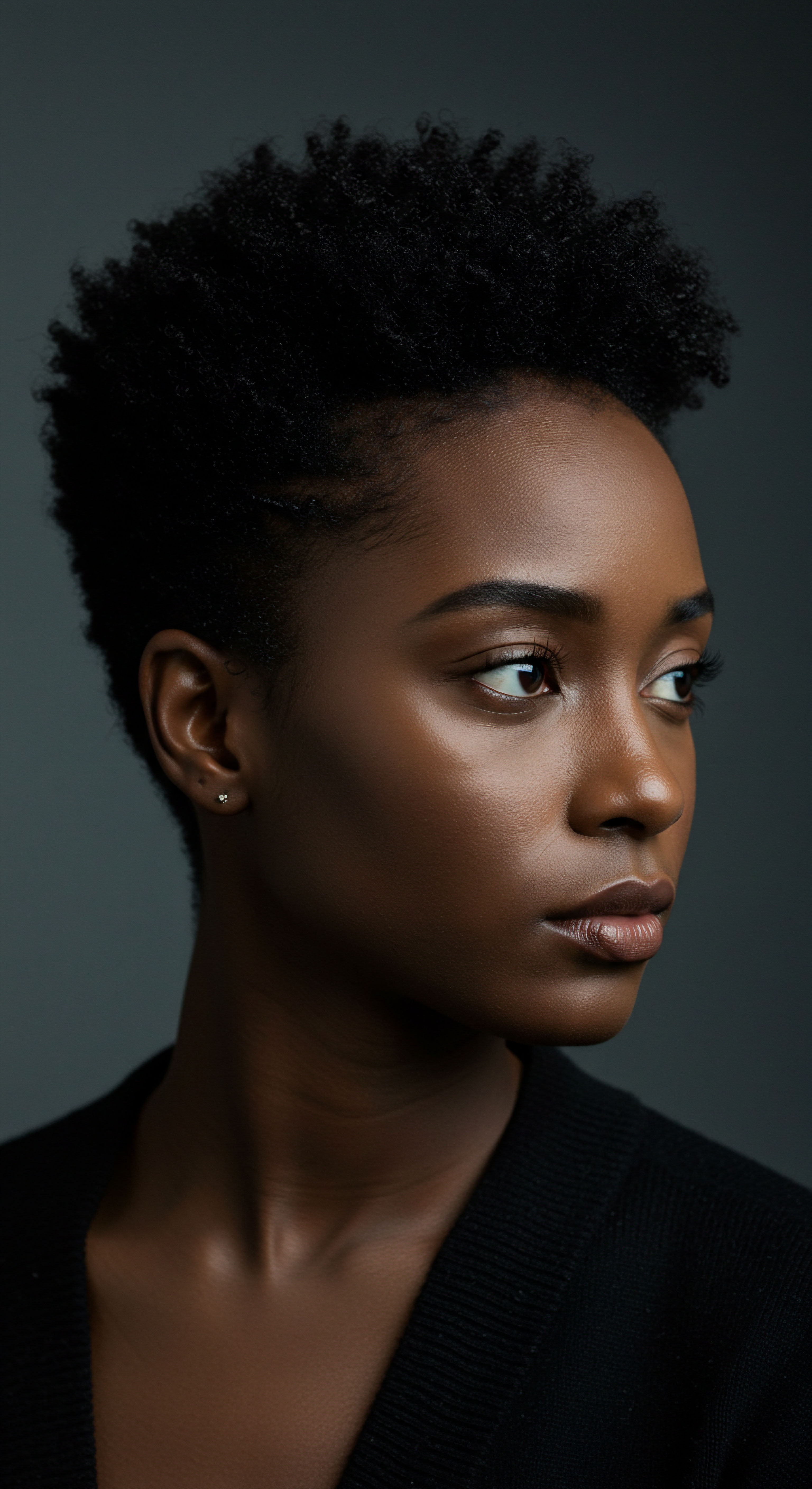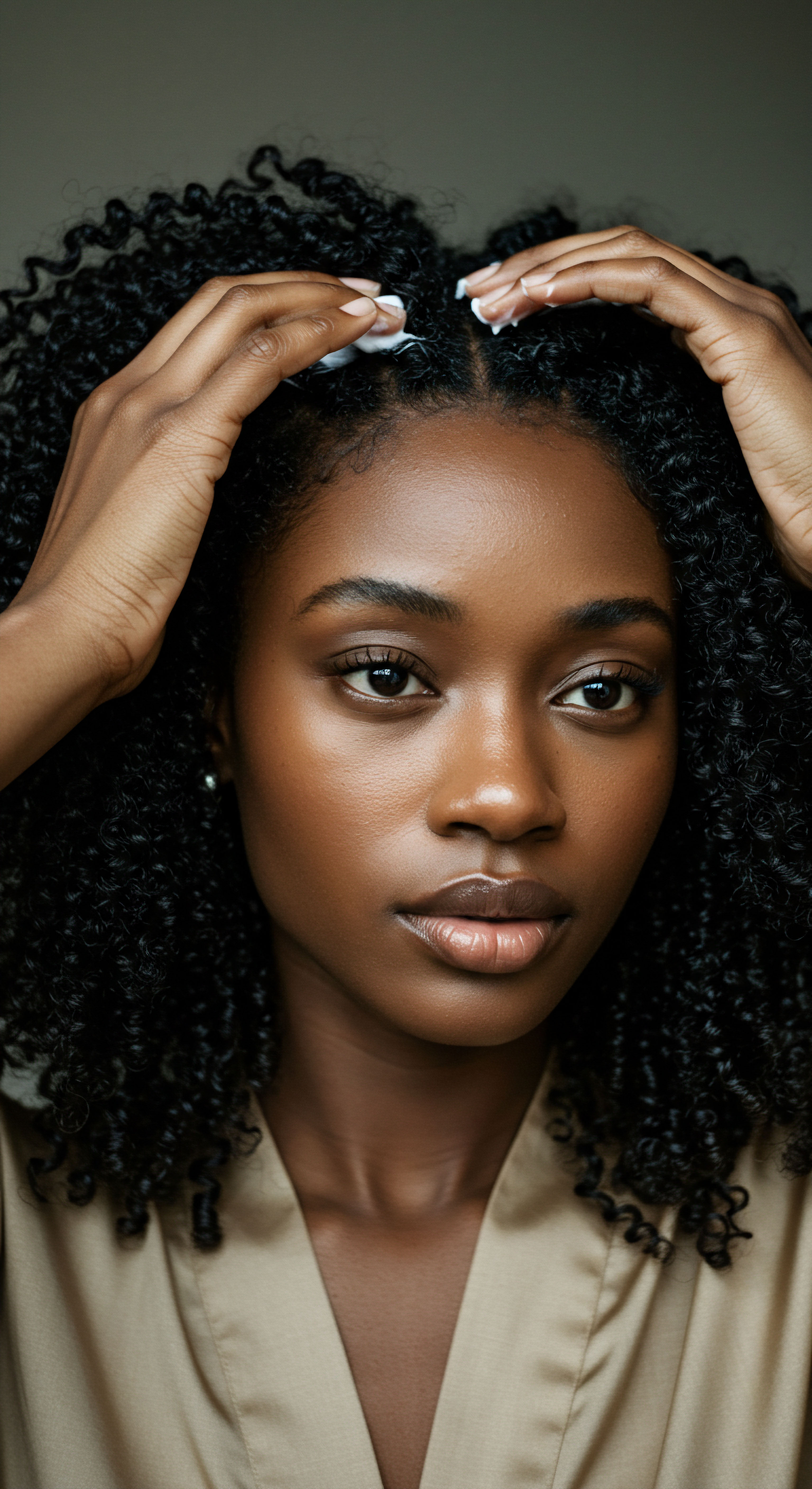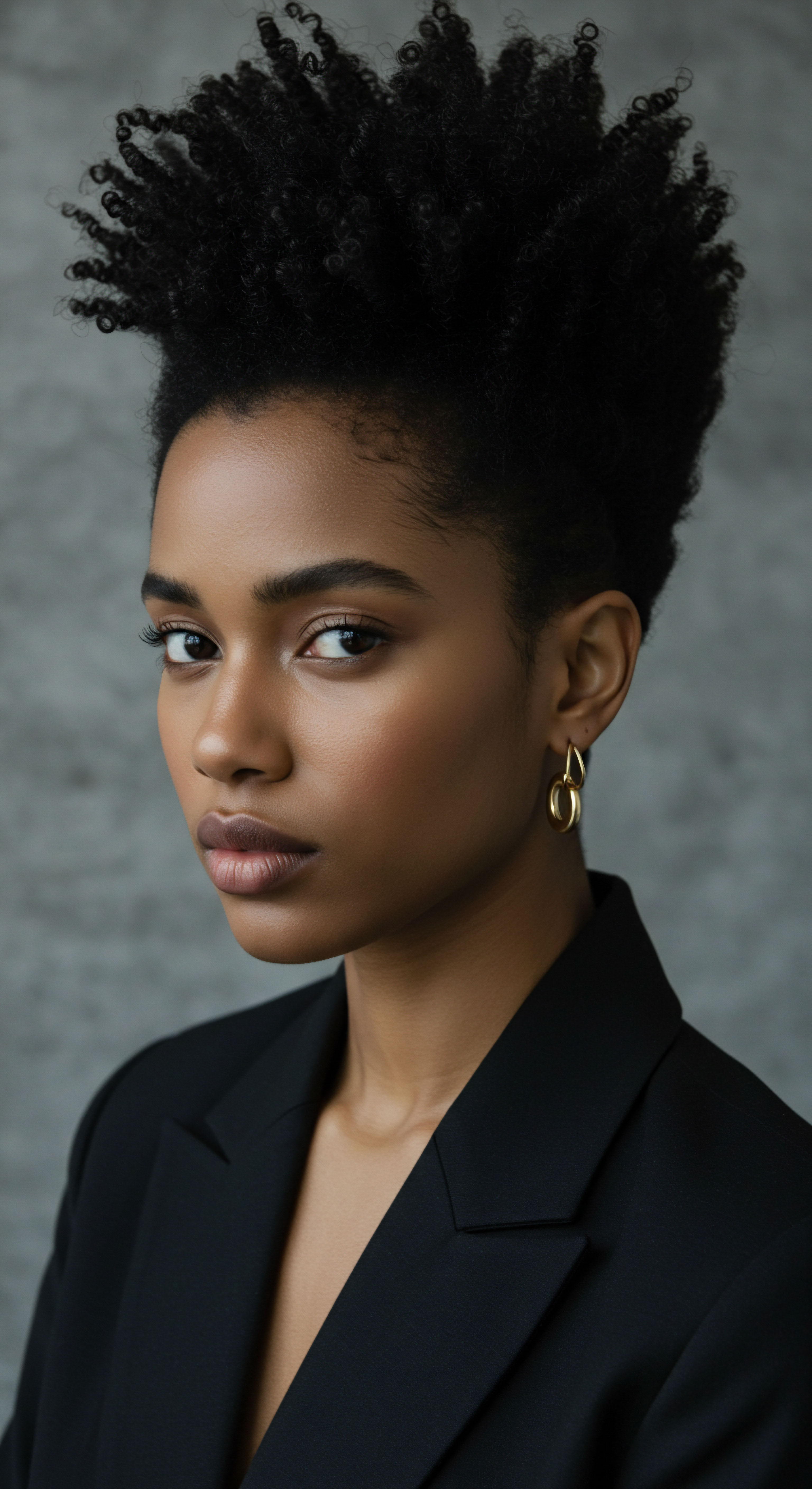
Roots
The quiet hours of night hold a profound, often overlooked, dialogue with our strands. As the world stills and we retreat into slumber, a silent, intricate ballet of biological processes unfolds within us, profoundly influencing the very life cycle of our hair. This is not merely about rest for tired limbs; it is a period of deep cellular recalibration, a time when the body’s internal chronometer dictates the rhythm of growth, repair, and renewal. Our hair, far from being a passive adornment, listens intently to these nocturnal whispers, responding to the subtle shifts in our internal chemistry.
Understanding the foundational architecture of hair’s existence begins with recognizing its cyclical nature. Each individual hair follicle on our scalp operates on its own precise timeline, moving through distinct phases of activity. This rhythmic progression ensures a continuous turnover, shedding older strands to make way for new, vibrant growth.

Hair Anatomy and Physiology Specific to Textured Hair
Textured hair, with its unique helical structure, presents a fascinating study in biomechanics and biology. Unlike straight hair, which tends to be round in cross-section, textured strands often exhibit an elliptical or even flattened shape. This structural distinction, combined with the way the hair follicle itself curves within the scalp, gives rise to the characteristic coils, curls, and waves we admire.
The very architecture of the textured hair follicle impacts how it responds to internal signals. The journey of a hair strand begins deep within the dermis, where the follicle, a tiny organ, houses the dermal papilla—a cluster of cells vital for hair growth. Surrounding this is the hair matrix, where cells rapidly divide and differentiate, pushing upward to form the hair shaft.
The unique curvature of the follicle in textured hair means that these rapidly dividing cells are not laid down in a perfectly straight column, leading to the characteristic bends and twists. This intricate cellular choreography is susceptible to various internal influences, including the subtle cues from our endocrine system.

Hair Growth Cycles and Influencing Factors
The life of a hair strand unfolds in three primary acts:
- Anagen The growth phase, a period of active cellular division and elongation. For scalp hair, this can span several years, dictating the ultimate length a strand can attain.
- Catagen A brief, transitional phase where growth ceases, and the hair follicle shrinks, preparing for the resting stage.
- Telogen The resting phase, during which the hair remains in the follicle but is no longer growing. This phase precedes shedding, making way for a new anagen hair.
This cyclical dance is not merely a predetermined biological clock; it is finely tuned by a symphony of internal and external factors. Nutrition, stress levels, genetics, environmental exposures, and certainly, our hormonal landscape, all play a part in dictating the tempo and duration of these phases. When this delicate balance is disrupted, the hair cycle can falter, leading to concerns like thinning or excessive shedding. It is in the quiet hours of sleep that some of the most significant hormonal orchestrations occur, subtly directing the very fate of our strands.
The intricate dance of hair growth phases is a delicate ballet, profoundly influenced by the body’s internal rhythms, particularly those orchestrated during sleep.

Ritual
The nightly ritual, often seen as a simple winding down, is, for our hair, a profound conversation with our inner landscape. As the day’s demands recede, the body enters a state of deep restoration, a period where the influence of our sleep-regulating hormones becomes most pronounced. Understanding this nightly dialogue offers not just practical wisdom for hair care, but a deeper respect for the interconnectedness of our wellbeing. The choices we make as twilight descends can either harmonize with these natural rhythms or create discord, with our hair often bearing the silent testament.

How Do Hormones Like Melatonin and Cortisol Influence Hair Growth Cycles During Sleep?
The endocrine system, our body’s internal messenger network, works tirelessly, and during sleep, two particular hormones, melatonin and cortisol, take center stage in a fascinating, often contrasting, performance that significantly impacts our hair.

Melatonin’s Nocturnal Overture for Hair
Melatonin, often hailed as the hormone of darkness, rises with the setting sun, signaling to our bodies that it is time for rest. Its primary role is to regulate our circadian rhythm, the body’s natural sleep-wake cycle. Yet, its influence extends far beyond mere slumber. Emerging research indicates that melatonin also acts as a potent antioxidant and a regulator of cellular activity, including that within our hair follicles.
Within the hair follicle, melatonin appears to extend the Anagen phase, promoting sustained growth. It seems to achieve this by protecting follicle cells from oxidative stress, a common culprit in cellular damage and premature aging. Furthermore, melatonin may directly stimulate the production of growth factors within the follicle, essentially providing a fertile environment for robust hair development.
A study published in the Journal of Pineal Research found that topical application of melatonin could significantly increase anagen hair count in women with hair thinning, suggesting a direct stimulatory effect on the hair cycle. This suggests that the natural surge of melatonin during healthy sleep provides a vital, growth-promoting signal to our strands.

Cortisol’s Daytime Cadence and Nighttime Retreat
Cortisol, often termed the stress hormone, follows a nearly inverse pattern to melatonin. Its levels typically peak in the morning, helping us wake and respond to daily demands, and gradually decline throughout the day, reaching their lowest point during the deepest stages of sleep. This diurnal rhythm is crucial for overall bodily function.
When cortisol levels remain elevated, particularly at night due to chronic stress or disrupted sleep, it can have a detrimental effect on hair health. High cortisol can push hair follicles prematurely from the Anagen (growth) phase into the Catagen (transitional) or Telogen (resting/shedding) phases. This phenomenon is often seen in conditions like telogen effluvium, where widespread hair shedding occurs following a significant stressor. The sustained presence of cortisol can also interfere with the signaling pathways necessary for healthy hair growth, effectively sending a message to the follicles to slow down or cease production.
| Hormone Melatonin |
| Typical Circadian Rhythm Rises at night, peaks during sleep |
| Influence on Hair Cycle Promotes and extends anagen (growth) phase, antioxidant protection for follicles. |
| Hormone Cortisol |
| Typical Circadian Rhythm Peaks in morning, declines at night, lowest during deep sleep |
| Influence on Hair Cycle Elevated levels can prematurely push follicles into catagen/telogen (resting/shedding) phases. |
| Hormone Understanding these rhythms helps inform holistic hair care practices, particularly those surrounding sleep. |

The Symbiotic Relationship of Sleep and Hair
The influence of these hormones during sleep underscores the profound connection between restful nights and vibrant hair. When sleep is deep and consistent, melatonin’s beneficial effects are maximized, supporting cellular repair and growth. Conversely, fragmented or insufficient sleep can disrupt cortisol’s natural decline, keeping levels elevated and potentially contributing to a state of chronic stress that can undermine hair vitality. The body’s natural inclination towards rest is, in essence, a profound act of care for every cell, including those that give life to our hair.
Healthy sleep patterns allow melatonin to extend hair’s growth phase while permitting cortisol levels to recede, fostering an environment conducive to robust hair development.

The Nighttime Sanctuary Essential Sleep Protection and Bonnet Wisdom
Creating a sanctuary for sleep extends beyond just our minds and bodies; it envelops our hair as well. For textured hair, the nighttime hours present a unique set of considerations, and the practices adopted can significantly mitigate friction, preserve moisture, and honor the hair’s delicate structure during its period of nocturnal repair.

Preserving Moisture and Structure
Textured hair, by its very nature, is prone to dryness due to the difficulty of natural oils traveling down its coiled shaft. The environment of our sleep space can either exacerbate this or offer a protective shield. Traditional cotton pillowcases, while comfortable, are highly absorbent, drawing moisture from our strands throughout the night. They also create friction, which can lead to tangles, breakage, and the disruption of curl patterns.
This is where the wisdom of sleep protection, particularly the use of satin or silk bonnets and pillowcases, comes into its own. These materials possess a smooth, low-friction surface that allows hair to glide rather than snag. This minimizes mechanical stress, preserves the integrity of the hair cuticle, and crucially, helps to retain the hair’s natural moisture, which is vital for its resilience and growth. The gentle slide of hair against satin reduces the likelihood of frizz and breakage, allowing the hair to rest undisturbed during its period of hormonal orchestration.

Aligning with the Body’s Repair Cycle
Just as our skin and internal organs undertake significant repair and regeneration during sleep, so too do our hair follicles. The nightly dip in cortisol and surge in melatonin provide an optimal biological window for these processes. By creating a protective environment for our hair, we are not only preventing external damage but also supporting the internal biological mechanisms that are at play. A well-protected head of hair is less likely to experience the micro-traumas that can prematurely signal a follicle to enter its resting phase, allowing the anagen-extending benefits of melatonin to fully express themselves.

Relay
Beyond the surface-level observations of hair’s response to sleep, lies a deeper, more complex interplay of molecular signals and cellular communication. How does the body’s internal clock, regulated by melatonin and cortisol, communicate with the seemingly autonomous hair follicle? This inquiry leads us into the intricate cellular mechanisms that govern hair growth, revealing a sophisticated biological relay system where hormones act as messengers, dictating the very pace and quality of our strands’ existence. The narrative of hair growth, when viewed through this lens, becomes a testament to the body’s profound interconnectedness, a silent symphony of signals echoing ancestral wisdom and modern science.

Cellular Signaling and Hair Follicle Dynamics
The hair follicle is a highly dynamic mini-organ, home to various cell types, each playing a specific role in the hair growth cycle. These cells are equipped with receptors, molecular antennae that pick up signals from circulating hormones and growth factors. The ability of the follicle to respond to melatonin and cortisol lies in the presence of these specific receptors on its cells.
Melatonin Receptors ❉ Research indicates that hair follicles, particularly those in the anagen phase, possess melatonin receptors (MT1 and MT2). When melatonin binds to these receptors, it initiates a cascade of intracellular events. This includes the activation of pathways that promote cell proliferation in the hair matrix, thereby extending the anagen phase.
Furthermore, melatonin’s antioxidant properties help to neutralize reactive oxygen species (ROS) that can damage follicular cells and prematurely trigger the catagen phase. By mitigating oxidative stress, melatonin helps maintain the health and longevity of the hair follicle, allowing it to sustain growth.
Glucocorticoid Receptors (for Cortisol) ❉ Hair follicle cells also contain glucocorticoid receptors, which bind to cortisol. While cortisol is essential for many bodily functions, chronic or excessive binding to these receptors within the hair follicle can have inhibitory effects. High cortisol levels can suppress the activity of growth-promoting factors and promote the expression of genes that induce apoptosis (programmed cell death) in follicular cells.
This can lead to a premature shift from the anagen to the catagen or telogen phase, resulting in hair thinning or shedding. The precise mechanisms are still being elucidated, but it is clear that a balanced cortisol rhythm is essential for optimal hair cycle regulation.
The hair follicle, a responsive miniature organ, contains specific receptors for both melatonin and cortisol, allowing these hormones to directly influence its growth and resting phases.

The Circadian Clock Within the Follicle
Beyond the systemic hormonal signals, there is a growing understanding that hair follicles themselves possess an intrinsic circadian clock. This internal molecular clock, similar to the master clock in the brain’s suprachiasmatic nucleus (SCN), is composed of a set of “clock genes” (such as CLOCK, BMAL1, PER, and CRY) that oscillate in a roughly 24-hour rhythm. These local clocks in the hair follicle likely synchronize with the central SCN clock, partly through hormonal cues like melatonin and cortisol.
This local follicular clock influences the timing of various cellular processes, including DNA synthesis, cell division, and metabolic activity within the hair follicle. Disruptions to this delicate follicular rhythm, perhaps due to chronic sleep deprivation or shift work, could desynchronize the local clock from the systemic hormonal signals, potentially leading to dysregulation of the hair growth cycle. For instance, if the follicular clock is “confused” about the time of day, it might not be optimally primed to receive melatonin’s growth-promoting signals at night or to appropriately respond to cortisol’s daytime cues.

Seasonal Hair Shedding and Hormonal Rhythms
The concept of seasonal hair shedding, a phenomenon observed in many mammals and increasingly recognized in humans, offers a compelling example of how hormonal rhythms, possibly influenced by photoperiod (daylight length), interact with hair cycles. While not directly tied to sleep hormones alone, it demonstrates the body’s capacity to adjust hair growth in response to environmental cues, mediated by the endocrine system. Some theories suggest that subtle changes in melatonin secretion patterns across seasons, influenced by varying light exposure, could play a part in modulating hair follicle activity, leading to periods of increased shedding or growth. This highlights the sensitivity of the hair follicle to even subtle, long-term shifts in hormonal balance.
A noteworthy observation, sometimes debated in the scientific community, suggests that human hair density might show seasonal variations. A study examining hair growth in European women found a higher proportion of telogen hairs (resting/shedding phase) in summer and early autumn, suggesting increased shedding during these periods. While this particular study did not directly measure melatonin or cortisol, it aligns with the idea that environmental factors, potentially influencing hormonal patterns, contribute to these cyclical changes in hair. This subtle ebb and flow of hair, often unnoticed, underscores the sophisticated communication between our inner world and our external environment, with hormones acting as vital intermediaries.

Why Do Sleep Disturbances Affect Hair Health?
The profound impact of sleep disturbances on hair health can be understood through the lens of sustained hormonal dysregulation and its cascading effects on follicular function. When sleep is consistently disrupted, the natural ebb and flow of melatonin and cortisol are thrown into disarray.
- Suppressed Melatonin Secretion ❉ Chronic sleep deprivation or exposure to artificial light at night (blue light from screens) can suppress the natural nighttime surge of melatonin. This means the hair follicles are deprived of melatonin’s protective and growth-promoting signals, potentially shortening the anagen phase and making the follicles more vulnerable to damage.
- Elevated Nighttime Cortisol ❉ Poor sleep quality, particularly insomnia or frequent awakenings, can prevent cortisol levels from dropping sufficiently at night. This sustained elevation creates a chronic stress response within the body, directly impacting hair follicles. The prolonged exposure to high cortisol can prematurely trigger the hair to enter the resting and shedding phases, leading to noticeable hair thinning.
- Increased Oxidative Stress and Inflammation ❉ Disrupted sleep is also linked to increased systemic inflammation and oxidative stress throughout the body. These conditions create a hostile environment for hair follicles, damaging their delicate cellular machinery and further impeding healthy growth. The protective benefits of melatonin, which would typically counteract some of this, are diminished when sleep is poor.
The interplay of these factors creates a feedback loop ❉ poor sleep impacts hormones, which impacts hair, and the visible changes in hair can, in turn, cause further stress, perpetuating the cycle. This underscores the importance of viewing hair health not in isolation, but as an integral part of our overall physiological and emotional wellbeing, deeply connected to the sanctity of our sleep.

Reflection
As the quiet hum of the night descends, bringing with it the restorative balm of sleep, our hair, too, enters a profound state of rejuvenation. The intricate dance of melatonin and cortisol, far from being mere background noise, emerges as a vital, silent symphony orchestrating the very life of our strands. This understanding invites us to view our hair not just as a physical attribute, but as a living, responsive entity, intimately connected to the deep rhythms of our being. It encourages a gentle, knowing approach to care, one that honors the body’s natural wisdom and the subtle, yet powerful, influence of our internal world.

References
- Fischer, T. W. Burmeister, G. Schmidt, N. Hempel, G. & Elsner, P. (2004). Melatonin increases anagen hair rate in women with androgenetic alopecia or diffuse alopecia ❉ results of a pilot randomized controlled trial. Journal of Pineal Research, 36(3), 209-216.
- Courtois, M. Loussouarn, G. Hourseau, C. & Grollier, J. F. (1995). Hair cycle and hair density in Caucasian females. British Journal of Dermatology, 132(1), 86-93.
- Paus, R. & Cotsarelis, G. (1999). The biology of hair follicles. New England Journal of Medicine, 341(7), 491-497.
- Hardman, J. G. Limbird, L. E. & Gilman, A. G. (Eds.). (2001). Goodman & Gilman’s The Pharmacological Basis of Therapeutics (10th ed.). McGraw-Hill.
- Slominski, A. T. Witalinska, M. Rudnicka, J. & Zmijewski, M. A. (2014). The circadian clock and the skin ❉ a review of the mechanisms and their clinical implications. International Journal of Molecular Sciences, 15(7), 12613-12644.
- Andersen, M. L. & Tufik, S. (2005). The role of sleep in neuroendocrine regulation. Current Pharmaceutical Design, 11(25), 3295-3301.
- Headington, J. T. (1984). Telogen effluvium ❉ New concepts and review. Archives of Dermatology, 120(10), 1279-1282.
- Sprenger, F. & Kretzschmar, K. (2020). Hair Follicle Stem Cells and Their Niche ❉ Regulation of Hair Growth and Beyond. Stem Cells, 38(2), 221-231.